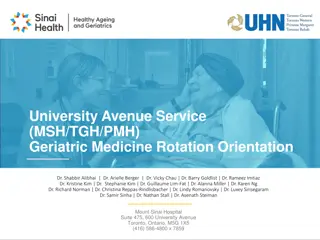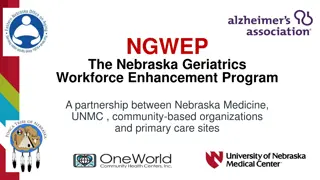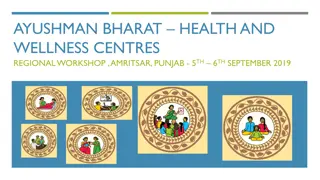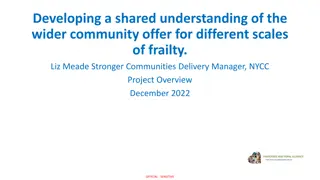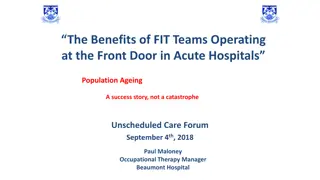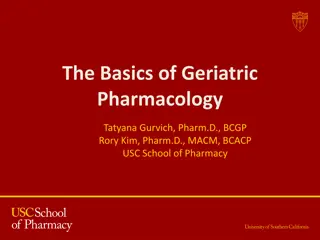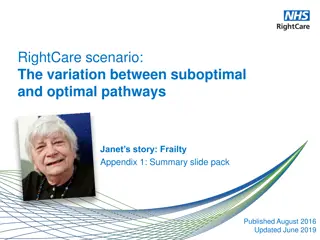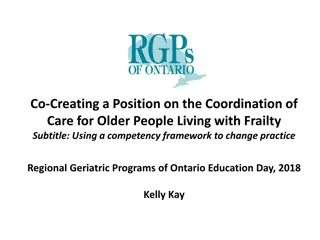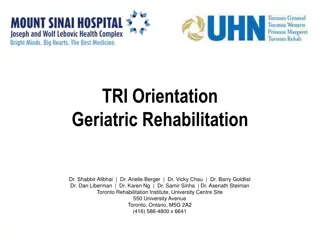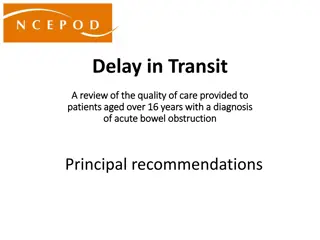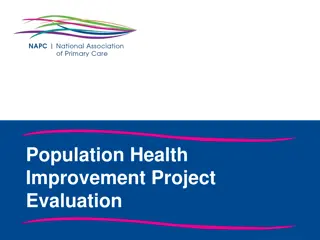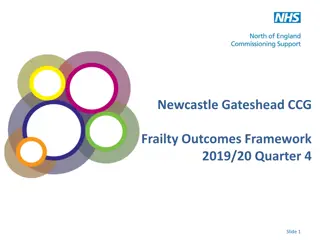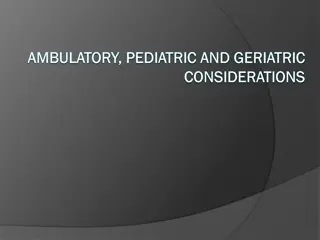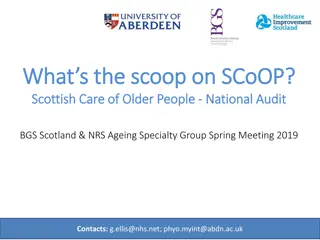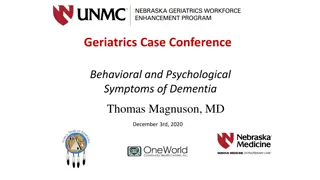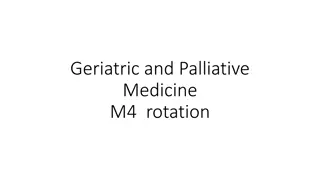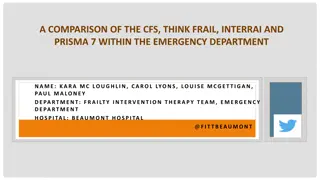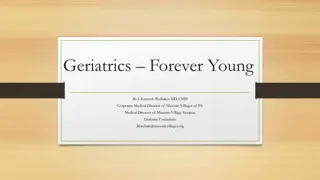Understanding Frailty in Geriatric Care
Frailty in older adults is a clinical state of vulnerability with risks for adverse outcomes. It is distinct from old age or morbidity and requires careful identification due to its association with adverse events. Screening for frailty is crucial to target interventions effectively and improve patient care.
Download Presentation

Please find below an Image/Link to download the presentation.
The content on the website is provided AS IS for your information and personal use only. It may not be sold, licensed, or shared on other websites without obtaining consent from the author. Download presentation by click this link. If you encounter any issues during the download, it is possible that the publisher has removed the file from their server.
E N D
Presentation Transcript
Frailty Claire Solomon Consultant Geriatrician Frailty Lead Charing Cross Hospital Imperial College Healthcare NHS Trust
Objectives To understand what is meant by Frailty To understand the importance of diagnosing frailty To understand the different ways we identify frailty To understand successful (and the ineffective) interventions for frailty The Frailty Service at Imperial Case studies
What is frailty? Inflammation, immune system failure and dysregulation of neuroendocrine pathways leading to skeletal muscle decline There is no gold standard for diagnosis It IS however a distinct entity from old age or multi- morbidity or cognitive impairment Some older patients remain fit, well and active while others have gradual, unrelenting functional decline 4 to 16 % in men and women aged 65 and older (USA)
What is frailty A clinical state of vulnerability with inherent risks for adverse clinical outcomes Hallmark geriatric syndrome Poor functional reserve - small insults result in large, steep, sudden declines in function and/or cognition
Why do we need to identify frailty? Frailty is central to the activity of every healthcare provider Frailty increases the risk of acute unscheduled admission Frailty predisposes patients to poorer outcomes (falls, procedural complications, institutionalisation, disability, death) Frailty is a pre-terminal diagnosis 1/3 of patients not managing at home will be dead within 12 months
Frailty screening Utilised to identifyolder adults at high risk of adverse outcomes in a variety of clinical settings Important to target the correct patients for intervention not those too well or too sick Their direct prognostic ability or clinical role is limited and challenging As an exercise in Frailty recognition and improving care, are effective.
Identifying Frailty Much research exists now looking at frailty as a clinical and physiological entity Different frailty scores: no gold standard 2 categories 1. The Frailty Phenotype (FRAIL, Rockwood) 2. The accumulation-of-deficits model the more medical conditions and impairments a person has, the more frail (eFI, Edmonton) Only as good as the team using them Many now in routine clinical use
FRAIL screening tool Fatigue ("Are you fatigued?") Resistance ("Can you (not) climb one flight of stairs?") Ambulation ("Can you (not) walk one block?") Illnesses (greater than five) Loss of weight (greater than 5 percent) "Yes" to three or more questions indicates frailty. "Yes" to one or two questions indicates pre-frailty
eFI Uses data from the GP electronic health record to identify and grade frailty Data from around one million UK patients Identifies older people who are fit or mildly, moderately or severely frail It accurately predicts risk of nursing home admission, hospital admission, length of hospital stay and mortality Uses routinely available data (36 domains), without the need for an additional clinical assessment. Implemented into the SystmOne GP electronic health record and the two other main UK GP electronic health records (EMISWeb and Vision) is at an advanced stage. Community programmes case-finding using eFI include developing a tiered community frailty service for older people identify patients for pharmacist-led medication reviews identifying patients for proactive falls prevention treatment.
Imperial Daily Frailty Report: all over 70s scored 3 or above, last 72 hours Encounter Identifier Millennium Consultant Current / Last Facility CXH Current / Last Building CX Twr 10 S Current / Last Ward CX 10S Current / Last Room Bay D MRN Name Birth DateSex Admit Date & Time 11/09/2018 15:04 Current / Last Bed Bed 01 First Frailty Scale Category 5 Male Female 11/09/2018 06:30 CXH CX Twr 10 S CX 10S Side Room B SR B 4 Female 08/09/2018 14:43 CXH CX Twr 11 N CX 11N Large Bay Bed 10 7 Male 10/09/2018 05:50 CXH CX Twr 11 S CX 11S Neuro Bay E Bed 04 6 Female 07/09/2018 02:30 CXH CX Twr 04 S CX 4S Bay A Bed 02 5 Male 11/09/2018 09:17 CXH CX Twr 06 N CX 6N Bay A Bed 03 4 Female 09/09/2018 19:14 CXH CX Twr 06 N CX 6N Bay E Bed 02 4 Female 08/09/2018 19:41 CXH CX Twr 06 N CX 6N Bay E Bed 04 6 Female 07/09/2018 13:51 CXH CX Twr 06 N CX 6N Bay K Bed 01 5 Male 10/09/2018 18:14 CXH CX Twr 06 N CX 6N Side Room C SR C 4 Female 07/09/2018 14:11 CXH CX Twr 07 N CX 7N Bay A Bed 02 3 Female 09/09/2018 10:36 CXH CX Twr 07 W CX 7W Rav Bay F Bed 04 6 Male 07/09/2018 08:55 CXH CX Twr 08 S CX 8S Bay F Bed 03 5 Female 10/09/2018 18:02 CXH CX Twr 08 W CX 8W MFE Bay A Bed 03 6 Female 08/09/2018 12:30 CXH CX Twr 08 W CX 8W MFE Bay F Bed 01 7
The common frailty syndrome presentations are: delirium falls acute or sub acute decline in mobility not managing at home recurrent attendances/frequent contact with services weight loss not eating and drinking incontinence pressure ulcers sleep disorders + sensory deficits fatigue dizziness
Frailty interventions: what works? Specialist organised multidisciplinary geriatric diagnostic and treatment process as represented by a CGA (comprehensive geriatric assessment) is the gold standard of care (Cochrane 2011, 2017) CGA domains include: Functional capacity Falls risk Cognition Mood Polypharmacy Social support Financial concerns Goals of care Advance care preferences
Efficacy of CGA Meta-analyses have consistently found CGA improves detection and documentation of geriatric problems Whether CGA improves outcomes depends on CGA models and their settings Home geriatric assessment and acute geriatric care units have been shown to be consistently beneficial for several health outcomes. Co- management programmes eg orthogeriatrics has increasing evidence The data is conflicting for post-hospital discharge, outpatient geriatric consultation, and inpatient geriatric consultation services.
The best evidence is for: OT interventions Exercise Nutrition Medication reviews Advanced care plans/goal setting incl. palliative care involvement
There is no evidence for Testosterone supplementation Growth hormone supplementation DHEA-S supplementation Anti-inflammatory interventions
Frailty Services at Charing Cross ED + CDU liaison Monday Friday, 9-5 OPRAC (Older Persons Rapid Access Clinic) Patients needing Comprehensive Geriatric Assessment, therapy and diagnostics within approx. 1 week/at risk of admission within 24 hrs if urgent referrals via e-RS Frailty Unit Monday -Friday Short-stay admissions (24-48hrs) CGA plus other assessments/defined treatments/diagnostics/increases or new POC no monitored beds Email advice ICHC-tr.adviceelderlymedicine-imperial@nhs.net Telephone advice line Monday Friday, 9-5: CX 02033115162, SMH 07789 618954
OPAL (older persons assessment and liaison) Team Frailty team working on the AMU MFE wards 48 beds across 2 wards Rehabilitation ward 15 beds Clinics OPRAC Falls General The Virtual Ward CIS plus Imperial consultant geriatric input hospital-at-home Liaison with OPRAC Referrals from GPs or hospital on DC
Other trust frailty services SMH HH Orthogeriatrics Cardiology liaison Vascular liaison Renal liaison Trauma liaison MFE beds AMU-based frailty service/OPAL Memory clinic MFE beds General MFE clinic Falls clinic General MFE clinic
OPRAC case study: 1 Assessment: CGA incl. therapy ax and medication RV dementia bloods CT head ECG urinalysis MOCA Diagnosis: Likely advanced vascular dementia, possible normal pressure hydrocephalus Severe visual-spatial awareness deficits causing decreased mobility, in particular at doorways, on tiles, on darker coloured rugs. Interventions: Neurology review in OPRAC plus f/up arranged OP MRI brain to exclude NPH Carer education on dementia related gait disturbance, visual aids etc. Direct discussion with St Vincent s to ensure prompt review in memory clinic Commencement of a new POC Mr P, 75, referred by GP Rapidly deteriorating mobility and cognitive function Came to OPRAC accompanied by wife
OPRAC case study: 2 88 year old man GP referral with worsening DIB despite treatment for chest infection and a history of falls Assessment: CGA CXR bloods incl. d-dimer and BNP sats. on mobilising ECG CTPA Diagnosis Acute exacerbation of heart failure Interventions: IV diuretics patient kept over night on Frailty Unit up titration heart failure medication Referred to community HF team walking stick provided, patient declined referral to falls clinic D/Cd next morning - GP asked to continue monitoring U&Es and weight
OPRAC case study: 3 84 year old lady GP referral Advanced dementia and pressure ulcer over the hip worsening pain + discharge from pressure ulcer Pressure relieving mattress pre-arranged for OPRAC Assessment: CGA CT pelvis with contrast Review by infectious diseases team with wound swab Diagnosis: Clean pressure ulcer without underlying osteomyelitis Treatment: No need for antibiotics OT provided rota stand to facilitate transfers, Community OT referral made Up-titration of analgesia Advance care planning discussions with family


